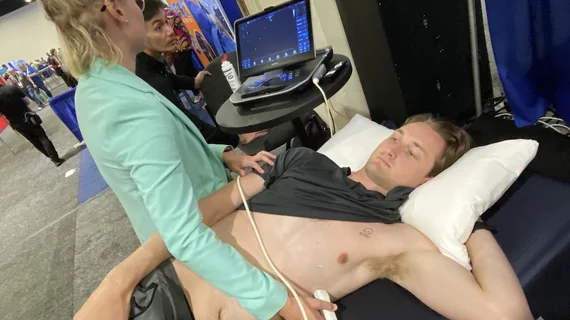ASE establishes vocabulary for cardiac POCUS to promote consistency
As cardiac point-of-care ultrasound (POCUS) use continues to grow outside of traditional echo labs, the American Society of Echocardiography (ASE) is working to ensure everyone speaks the same language when reporting on these exams. The group has issued a new guideline that aims to standardize the nomenclature in cardiac POCUS so everyone is on the same page when reading or discussing findings to reduce confusion and enhance patient safety.
The guideline, Recommendations for Cardiac Point-of-Care Ultrasound Nomenclature, establishes a deliberate vocabulary for cardiac POCUS-related terms to improve consistency. There was a growing concern that cardiac POCUS is used by clinicians from so many specialties that there could be inconsistencies in the language and terms they use.
“Many terms have been proposed to describe the use of ultrasound by bedside clinicians to image the heart, and the words we use matter,” James N. Kirkpatrick, MD, writing group chair and director of the echocardiography laboratory with University of Washington Medical Center in Seattle, said in a statement. “We believe our recommended terms and definitions can be an important step in bringing together the different specialties that use cardiac POCUS to standardize what we do—all for the good of the patient.”
The writing group included non-cardiologists that represent large groups of cardiac POCUS users. This included a group co-chaired by Nova Panebianco, MD, professor of emergency medicine and director of emergency ultrasound at the University of Pennsylvania, and Jose Luis Diaz-Gomez, MD, institute chair—integrated hospital care at Cleveland Clinic Abu Dhabi, and adjunct professor of anesthesiology at Baylor College of Medicine. Additionally, ASE said it included healthcare professionals from multiple stakeholder medical societies and a specialist in medical linguistics.
The guideline focuses on four main areas:
• Reviewing the evolution of cardiac POCUS-related terms.
• Outlining specific recommendations, distinguishing between intrinsic and practical differences in ‘‘basic cardiac POCUS/FoCUS,’’ ‘‘advanced cardiac POCUS,’’ ‘‘consultative echocardiography,’’ and ‘‘ultrasound assisted physical examination.’’
• Addressing the implications of these recommendations for current practice.
• Discussing the implications for novel technologies and future research.
Kirkpatrick, Panebianco and Diaz-Gomez all believe that a standard nomenclature can set the stage for future consensus building around the coordination of imaging studies, credentialing processes, billing practices, liability considerations, training protocols and research.
“We intend for this cardiac POCUS nomenclature to be a starting point for future work in more specific areas. Establishing a deliberate vocabulary is the foundation for the accurate and efficient transfer of medical knowledge among healthcare professionals, educators, administrators, insurance providers, credentialing bodies, and most importantly, patients,” Kirkpatrick said.
The document is endorsed by the American College of Chest Physicians (CHEST), the American College of Emergency Physicians (ACEP), the American Institute of Ultrasound in Medicine (AIUM), the American Thoracic Society (ATS), the Society of Critical Care Medicine (SCCM), World Interactive Network Focused on Critical Ultrasound (WINFOCUS) and 26 ASE International Alliance Partners.
ASE became an early supporter of POCUS, including educational tracks and training at its annual meeting. All guidelines published by ASE are available at ASEcho.org/Guidelines.

